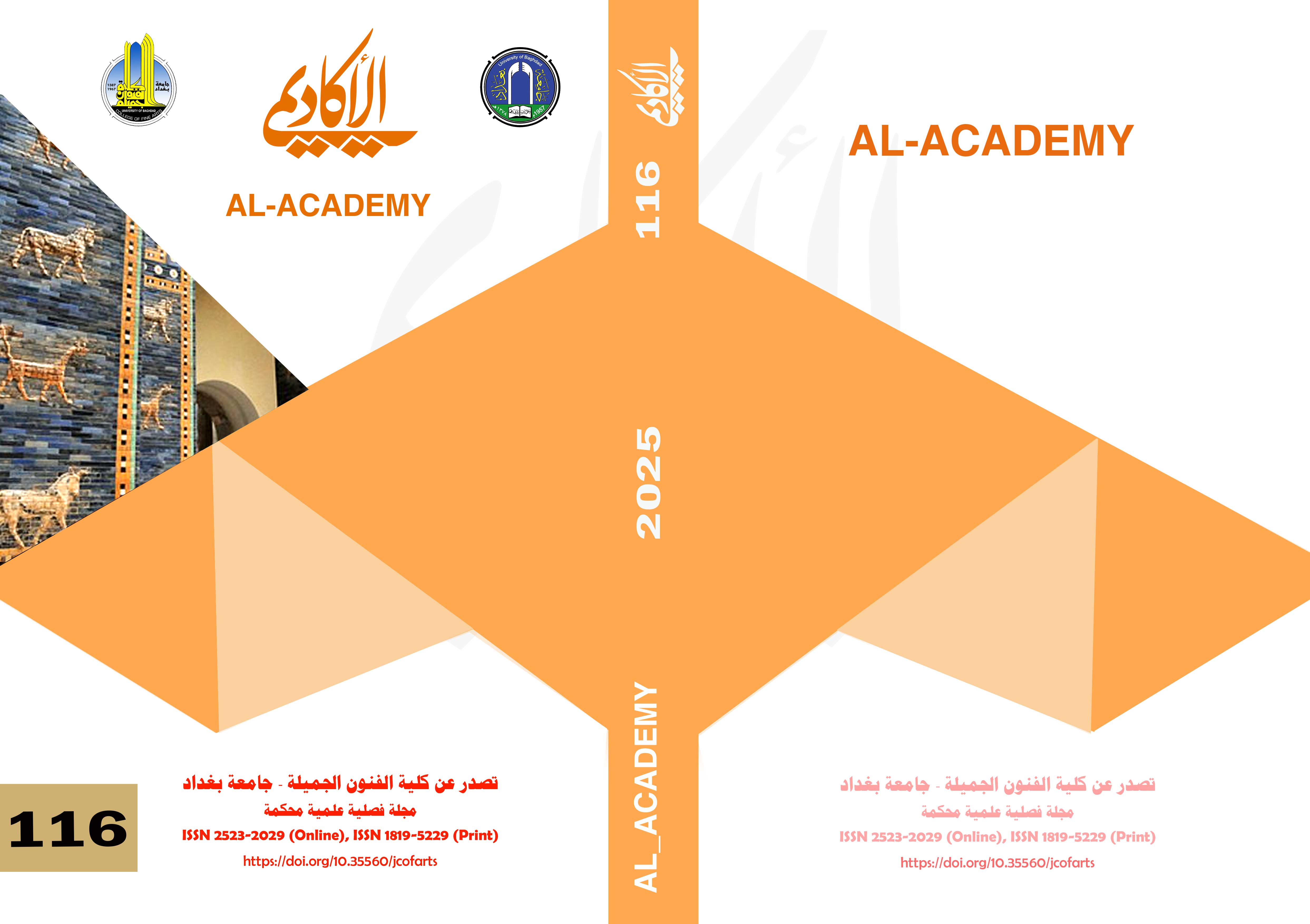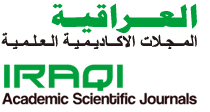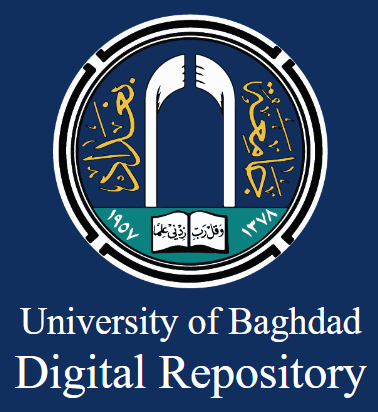Isomorphism and its approximation in Islamic art decorations
DOI:
https://doi.org/10.35560/jcofarts1418Keywords:
Isomorphism, approximation, decorationsAbstract
The current research includes four chapters , First chapter include a problem of the research which determined by [what is the isomorphism and its approximation in Islamic arts ornaments] , The second chapter includes three researches : concept of isomorphism , and references of ornamental shape , Aspects of decorative embellishment in Islamic art , as for the third chapter stated for search procedures , In light of it, the analysis was conducted in which the researcher relied on the system ,Descriptive and analytical in the process of analyzing models selected from the entire research community in accordance with the data of the content that embodies one of the sides of the concept of conformity. As for the fourth chapter, it included a number of results, including: It embodies their succession in works, formulation, performance, and type (gender) embodies a decorative composition that represents a situation Of the morphology, it led to the filling of meaning in the eyewitness through manipulation of the structural descriptions and the withdrawal of the decorative form in a way that achieves a dual function through naturalization (reading - decorative). The conclusions, including: that the ability and experience of the decorator have the most prominent role in choosing the optimal and appropriate methods of the appearance of the decorations, and they may be The adaptability and flexibility that characterize Islamic art decorations play a role in the ease of formation and combination, as these components demonstrate the artist’s ingenuity and skill in designing complex and interwoven shapes, which gives the artwork a high artistic value. The fourth chapter concluded with a proposal that could be a later study (representations of addition in the decorations of Islamic art).
References
- Ibn Manzur (d.d.). Arabes Tong . Gender subject, presented by Abdullah Al-Alayli, Arab Studies, Part 1, Beirut.
- Al-Ahmar, Faisal. (2010). Dictionary of Semiotics. 1st edition, Arab House of Science Publishers, Manshwaart Al-Tifaf, Algeria.
- Al-Alfi, Abu Saleh (1969). Islamic art, its origins, its philosophy, its schools. Dar Al-Maaref, Egypt, Cairo.
- Papadopoulou, Alexander (1979). Aesthetics of Islamic painting. Trans: Ali Al Lawati, published and distributed by Abdul Karim bin Abdullah Foundations, Tunisia.
- Barthes, Roland, et al. (1998). Prospects of intertextuality theory. Translated by Muhammad Khairy Al-Bikai, Egyptian General Book Authority, Cairo.
- Al-Bustani, Fouad, (d. d.). Upholstery. Beirut, Dar Al-Mashreq.
- Bashir, Abdel Ani (2019). “The term ambiguity between translation and critical practice.” Journal of Semiotic Research, Volume 8, Issue 14.
- Bahnasi, Afif. (1979). The aesthetics of Arab art. knowledge world.
- Bahnasi, Afif . (1997). Aesthetic thought according to Tawhidi. The Supreme Council of Culture
- Al-Tawhidi, Abu Hayyan. (d.d.) Enjoyment and sociability, Part 3, Al-Hayat Library for Printing, Publishing and Distribution, authenticated by: Ahmed Amin.
- Al-Jurjani, Ali bin Muhammad Al-Sharif. (1985). Definitions book. Lebanon Library, Beirut.
- Al-Jawhari, Abu Nasr Ismail bin Hammad. (2009). The correct one. Volume One, Dar Al-Hadith for Printing, Publishing and Distribution, Cairo.
- Hajim, Adi Abdel Hamid Majeed. (2006). “The art of decorating between theory and practice.” Unpublished master's thesis, College of Fine Arts, University of Baghdad, Baghdad, Iraq.
- Hadid, Taif Muhammad. (2022). “The Aesthetic Organization of Contemporary Islamic Painting Motifs,” Unpublished Master’s Thesis, College of Fine Arts, University of Baghdad, Baghdad, Iraq.
- Hamdawi, Jamil (2011). Semiology between theory and practice. 1st edition, Al Waraq Press for Publishing and Distribution, Amman.
- Daoud, Abd al-Rida Bahiya. (1989). “The Artistic Foundations of Wall Decorations in the Mustansiriya School,” unpublished master’s thesis. College of Fine Arts, University of Baghdad, Baghdad, Iraq.
- Al-Ruwaili, Megan and Saad Al-Bazai. (2002). The Literary Critic's Guide. 3rd ed., Arab Cultural Center, Casablanca, Morocco.
- Al-Zamakhshari, Abi Al-Qasim Jarallah Mahmoud bin Amr bin Ahmed. (1998). The Basis of Rhetoric, Part 1, edited by: Muhammad Basil Oyoun Al-Aswad, Dar Al-Kutub Al-Ilmiyyah, Beirut, Lebanon.
- Hussein, Souad Rasheed (2008). “Functional approaches between art education and the representation of visual thinking in developing the cognitive abilities of middle school students.” Unpublished master's thesis, College of Fine Arts, University of Baghdad, Baghdad, Iraq.
- Sultan, Munir. (2000). Rhythm in Shawqi’s lyric poetry. 1st edition, Al Maaref Building, Alexandria, Egypt.
- Al-Shafi’i, Farid. (1994). Arab Architecture in Islamic Egypt. Egyptian General Book Authority, Egypt.
- Shaalan, Sanaa. (2007). Strange and miraculous narratives. Qatar Dar Al-Kitab, Al-Jasra Cultural and Social Club.
- Salah, Fadl (1996). Rhetoric of speech and text science. 1st edition, Lebanon Library Publishers, Cairo,.
- Saliba, Jamil (1982). The Philosophical Dictionary, Part 1, Dar Al-Kitab Al-Lubnabi, Beirut, Lebanon.
- Abdel Amir, Wissam Kamel. (2003). Methods of designing floral decorations in the facades of the Abbasid Hazrat. Unpublished master's thesis, College of Fine Arts, University of Baghdad, Baghdad, Iraq.
- Abdel Nour, Jabour. (1984). Literary dictionary. 1-2 ed., Dar Al-Aam for Millions, a cultural institution for writing, translation and publishing, Beirut, Lebanon.
- Omar, Ahmed Mukhtar (2008). Contemporary Arabic Dictionary, 1st edition, first volume, Alam Al-Kitab Publishing, Distribution and Printing, Cairo.
- Al-Farouqi, Ismail Raji, and Louis Lamia Al-Farouqi. (1998). Atlas of Islamic Civilization. See: Abdul Wahed Lulua, Obeikan Library, Riyadh.
- Fidouh, Abdelkader. (1993). Semantics of the literary text. A semiotic study of Algerian poetry, Algerian Publications Office, Algeria.
- Al-Qazwini, Zakaria bin Muhammad bin Mahmoud Al-Kufi. (2000). The Wonders of Creatures, Animals, and Oddities of Existences, 1st edition, Al-Ilamyi Publications Establishment, Beirut, Lebanon.
- Qutb, Muhammad (1983). Islamic art curriculum. 6th edition, Dar Al Shorouk, Beirut.
- Al-Qayrawani, Abu Ali Al-Hasan Ibn Rashiq. (1907). Al-Umda fi making and criticizing poetry. 1st edition, part 2, Happiness Press.
- A committee of authors (1960). Intermediate dictionary. Part 1, Misr Company Press, Cairo.
- A group of authors (2010). Dictionary of narratives. Supervised by Muhammad Al-Qadi, 1st edition, Dar Muhammad Ali Publishing, Tunisia.
- Madkour, Ibrahim (1983). Philosophical dictionary. General Authority for Amiri Printing Press Affairs. Cairo Egypt.
- Matloob, Ahmed (1983). A dictionary of rhetorical terms and their development. Part 1-2-3, Iraqi Scientific Academy Press.
- Muftah, Muhammad (1985). Analysis of poetic discourse, intertextual strategy. 1st edition, Arab Cultural Center, Casablanca, Beirut.
- Al-Nouri, Amin Abdel-Zahra Yassin. (2015) “The aesthetic tributaries of Islamic thought and its representations in decorative decoration.” Unpublished doctoral dissertation, College of Fine Arts, University of Baghdad, Baghdad, Iraq.
- Al-Nouri, Amin Abdel-Zahra Yassin. (2019). "The strangeness of the formulation of form in the decorations of Islamic architecture." International Design Journal, Volume 9, Issue 2, College of Applied Arts, Cairo, Egypt.
- Wilson, Eva (d.d.). Islamic decorations and drawings. Trans: Amal Marioud, Dar Gabès for Printing, Publishing and Distribution, Beirut.
Downloads
Published
Issue
Section
License
Copyright (c) 2024 Thalfaa Ali Mahdi Altimimi, Amin Abdel Zahra Yassin

This work is licensed under a Creative Commons Attribution 4.0 International License.













